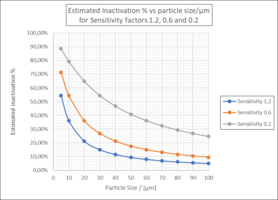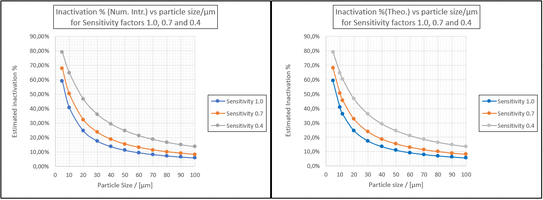Ellehcim60
New member
- Joined
- Jul 18, 2023
- Messages
- 9
Product inactivation, Pi for a particle in a hostile short term environment follows the following general formula:
Pi = 100 e-ε X/Tout
Where X is the penetration depth in μm from the particle surface, Tout is the outlet temperature of a dryer in degrees Kelvin and ε is a sensitivity factor (K/μm).
If we keep the dryer outlet temperature, Tout constant when comparing the total inactivation for different particle sizes, the equation becomes simpler:
Pi = 100 e-αX
Where α is again a sensitivity factor (μm-1).
The total product inactivation of a given particle can be approximated by calculating the average inactivation % for a given sphere shell, then step one sphere shell deeper and recalculate the average inactivation % for this shell and continue to do this until the center of the particle have been reached. Then the sum of all the sphere shell inactivation contributions can be calculated and divided with the total sphere/particle volume. This yields an approximation of the total Inactivation % of the entire spherical particle.
The approach is simple like linear integration but applied on spherical shells instead. A large spread sheet can do the job by using say 100 shell approximations for each particle ranging from 5 micron to 100 micron in average particle size in 10 particle size steps. The predicted total inactivation % as a function of the average particle size can then be plotted and a trend function fitted to the 10 data points.
But can the problem be solved mathematically?
Pi = 100 e-ε X/Tout
Where X is the penetration depth in μm from the particle surface, Tout is the outlet temperature of a dryer in degrees Kelvin and ε is a sensitivity factor (K/μm).
If we keep the dryer outlet temperature, Tout constant when comparing the total inactivation for different particle sizes, the equation becomes simpler:
Pi = 100 e-αX
Where α is again a sensitivity factor (μm-1).
The total product inactivation of a given particle can be approximated by calculating the average inactivation % for a given sphere shell, then step one sphere shell deeper and recalculate the average inactivation % for this shell and continue to do this until the center of the particle have been reached. Then the sum of all the sphere shell inactivation contributions can be calculated and divided with the total sphere/particle volume. This yields an approximation of the total Inactivation % of the entire spherical particle.
The approach is simple like linear integration but applied on spherical shells instead. A large spread sheet can do the job by using say 100 shell approximations for each particle ranging from 5 micron to 100 micron in average particle size in 10 particle size steps. The predicted total inactivation % as a function of the average particle size can then be plotted and a trend function fitted to the 10 data points.
But can the problem be solved mathematically?



